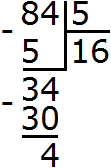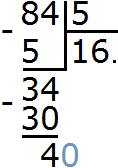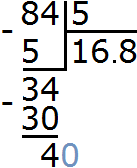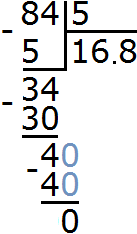In the division lesson we learned how to divide numbers with a remainder. For example, to divide 9 by 5, we did the following:

and went on to say that "nine divided by five would be one and four in the remainder".
Now we have the necessary knowledge to divide 9 by 5 without a remainder. Our task is to divide the remainder of 4 into 5 parts. In other words, divide a smaller number by a larger number.
So, let's put a dot after the one in the quotient, indicating that we have finished dividing the whole parts and are moving on to the fractional part:

Add zero to the remainder of 4

Now divide 40 by 5, and we get 8. Write the eight in the quotient:

What to do next we already know. Take out the remainder (if any). Multiply the eight by the divisor 5, and write down the result under 40:

40−40=0. We got 0 in the remainder. This completes the division. Dividing 9 by 5 results in a decimal of 1.8:
9 : 5 = 1.8
Example 2. Divide 84 by 5 without a remainder
First divide 84 by 5 as usual with a remainder:

We got a total of 16 and another 4 in the remainder. Now divide this residue by 5. We put a dot in the quotient and add 0 to the remainder of 4.

Now divide 40 by 5, and we get 8. Write the eight in the quotient after the point:

and finish the example by checking if there is still a remainder:

84 : 5 = 16.8
2. If you find an error or inaccuracy, please describe it.
3. Positive feedback is welcome.